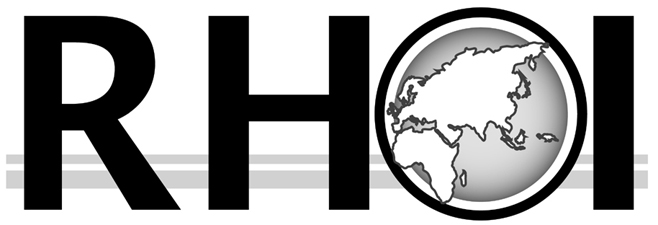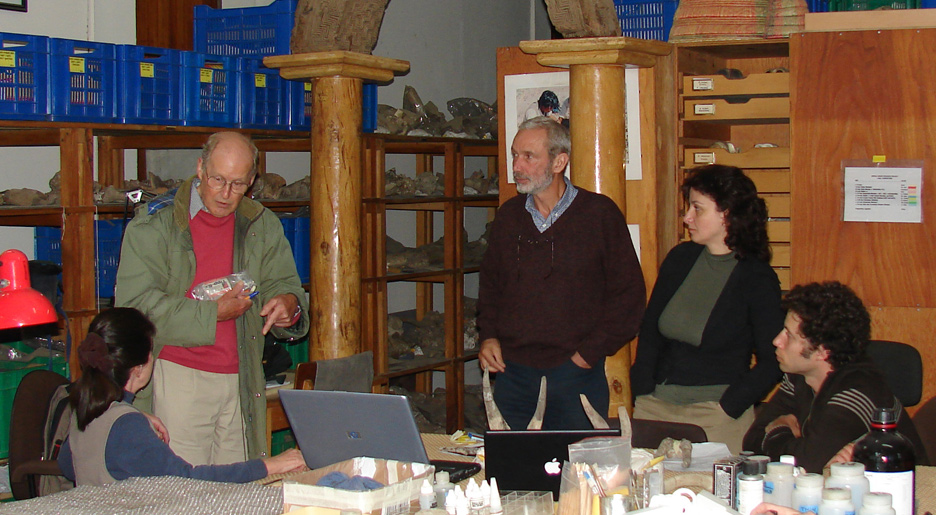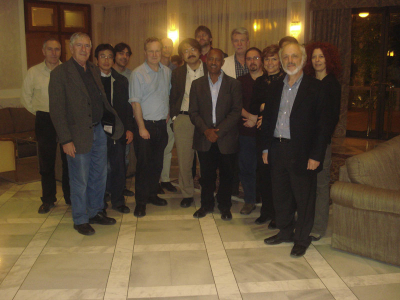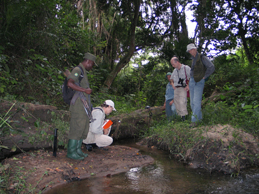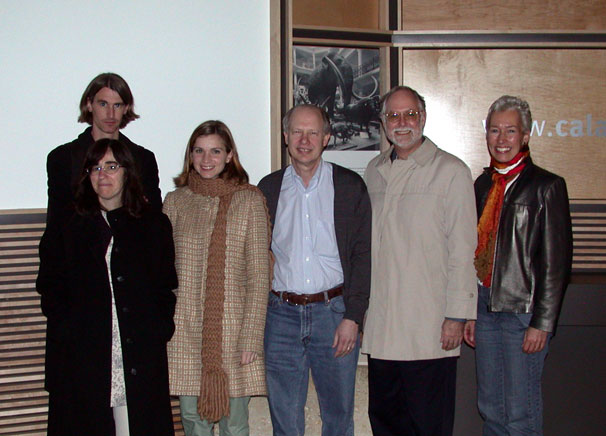HOME • EDUCATION • RHOI PUBLICATIONS • RHOI BIBLIOGRAPHY • RHOI STRUCTURE • INFORMATICS • MAP ARCHIVE: AWG NEWS
|
|
2008 ADDIS ABABA, ETHIOPIA (RHOI-supported) Per F. Bibi: The RHOI Bovid Analytical Working Group met for a conference in Addis Ababa from 4-8 August, 2008. Conference participants included Elisabeth Vrba, Alan Gentry, Denis Geraads, Maia Bukhsianidze, Dimitris Kostopoulos, and Faysal Bibi. In the mornings, attendees met at the Hilton Addis conference facilities to present and discuss topics relevant to the evolution of Bovidae. Attendees presented on new Mio-Pliocene specimens from Eurasia and Africa and focused on the question of the origin of the living bovid tribes during the late Miocene and their subsequent evolution during the Pliocene. Afternoons saw the group convening at the National Museum of Ethiopia to discuss and exchange observations on fossils from the Middle Awash and Omo collections. A summary paper of the conference's conclusions is in preparation.
Participants of the Bovid AWG conference (left to right: E. Vrba, A. Gentry, D. Geraads, M. Bukhsianidze, F. Bibi; behind camera: D. Kostopoulos) (Image: D. Kostopoulos)
POITIERS, FRANCE (RHOI-Supported) The Carnivore Analytical Working Group met over two days in late May, 2008, at the University of Poitiers, France. Convened by Louis de Bonis, the meeting was conducted in a presentation/discussion format, with research topics spanning the late-middle Miocene to early Pleistocene. Important contextual research by Morales and Pickford, on the middle Miocene carnivores from Muruyur Formation at Kipsaraman, was presented. This material adds much needed information to link, for example, early Miocene Amphicyonids with late Miocene forms. Other exciting research included late Miocene feliforms from Toros-Menalla, Chad (Peigne et al.), the As Sahabi carnivore guild (Rook and Sardella), small hyaenids from Lothagam (Semenov), a comparison of the late Miocene European and African carnivoran assemblages (Koufos and de Bonis), Middle Awash carnivores (Haile-Selassie), carnivores from Kossom Bougoudi, Chad (Peigne et al.), late Pliocene carnivores from Ahl al Oughlam, Morocco (Geraads), Plio-Pleistocene carnivores from South Africa (Hartstone-Rose), early Pleistocene Megantereon from Italy (Sardella), the evolution of African carnivores (Lewis), new canids from Aramis, Middle Awash, Ethiopia (Garcia), and the geographic patterning of African carnivore faunas (Werdelin).
THESSALONIKI, GREECE (RHOI-Supported) The Hominoid Analytical Working Group met March 27-29, 2008 in Thessaloniki, Greece. Organized by Jay Kelley and George Koufos and hosted by Professor Koufos and the Aristotle University of Thessalonki, the meeting topic was, "Late Miocene Euro-African hominoids and their relationships." Further details to follow.
Hominoid Conference Participants (Image: G. Koufos)
2006 TORO SEMLIKI, UGANDA (RHOI-supported) The Comparative Behavior and Ecology AWG met at Toro Semliki, Uganda from July 1-7, 2006. Four members (Hunt, Marchant, McGrew, Moore) were in attendance (the other two members, Foley and Stanford, were unable to attend). The group was hosted at the Chimpanzee Research Camp by its director, Kevin Hunt, and joined by two Ph.D. students, Alex Piel (UC-San Diego) and Gil Rmos (Indiana). Research at Toros Semliki focuses on the ecology and ethology of a wide-ranging community of partly habituated Pan troglodytes schweinfurthii. Each day included walking excursions to various areas that represent the ecological diversity of the site. When not in the bush, formal discussions were held in the late afternoons, and informal talk of related topics was constant from dawn until after dark, stimulated by the day’s events. Chimpanzees called often and were seen or tracked daily. Also, AWG members collected specimens of social insects, snails, soils, and associated GPS data. Discussion focused on planning future AWG activities and meetings. It was decided to organize a Wenner-Gren-style conference on the theme of ‘Primatology meets Paleoanthropology’, as a climax to the AWG’s activities. This likely will be held in late 2007, or early 2008, probably in Cambridge.
Toro Semliki, Uganda (Image: W.C. McGrew)
2005 NAIROBI, KENYA In August 2005, the Hippopotamid and Anthracotheriid Analytical Working Group (Jean-Renaud Boisserie, Denis Geraads, Andossa Likius, and Nikos Solounias) held its first meeting at the National Museums of Kenya in Nairobi. All four participants attended, in what was probably the largest group of African fossil hippo and anthracothere specialists ever gathered in the same room. The current status of fossil hippo and anthracothere studies was evaluated, and the need to explore some critical questions in the near future was emphasized, including the still unclear relationships between the two families, and the environmental factors that favored the apparently sudden emergence and spread of various hippo genera during the upper Miocene. The participants also developed common standards to be used for anatomical descriptions and morphometrical analyses of these mammals. Finally, discussions focused on the earliest hippopotamids, greatly benefiting from the access kindly provided by the National Museums of Kenya to their paleontological collections. AIX-EN-PROVENCE, FRANCE The first workshop of the Phytolith Analytical Working Group, entitled "Phytoliths in the context of RHOI," was held in May 2005 in CEREGE, Aix-en-Provence, France. Over two days, the participants examined the key issues related to the study of phytoliths at Aramis in the Middle Awash Valley, Ethiopia, the advantages, disadvantages, and similarities of various approaches to analyzing and interpreting phytolith data, and the progress to date on phytolith research and its limitations for the characterization of the environment of early hominids in east Africa. This meeting gave the Phytolith AWG the opportunity to prioritize the scientific themes concerning phytolith research in the context of RHOI, and to devise approaches and field work strategies that would allow an assessment of the precision and accuracy of phytolith-based environmental studies. OXFORD, OHIO, USA The Comparative Behavior and Ecology Analytical Working Group met 11-13 March 2005, hosted by the Department of Anthropology, Miami University, in Oxford, Ohio. The six AWG members (Robert Foley, Kevin Hunt, Linda Marchant, William McGrew, James Moore, and Craig Stanford), most of whom study the behavioral ecology of living apes, met with six counterpart palaeoanthropological colleagues, Bruce Latimer, Owen Lovejoy, Travis Pickering, Kathy Schick, Nick Toth, and Thomas Wynn. The meeting was done in informal, workshop-style, around a single table, and focussed on the following themes of Primatology Meets Palaeoanthropology: How can field primatologists frame questions that yield answers of interest and use to palaeoanthropologists in their reconstruction and modelling of hominid origins? How can palaeoanthropologists give guidance in framing questions or issues that are feasibly investigated by primatologists? Topics ranged from bipedality to the use of fire, with each participant posing, sometimes provocatively, points of interest, seeking engagement with the others. The general result was that there were many more interfaces that either side had previously suspected, and future AWG activities will follow up on these. SANTA FE, NEW MEXICO, USA Geologists with broad experience and interests in tephra studies from Canada, Eritrea, Ethiopia, Japan, Kenya, and the United States attended the Revealing Hominid Origins Initiative (RHOI) Tephra Analytical Working Group workshop at the Radisson Hotel, Santa Fe, New Mexico, between March 12, 2005 and March 16, 2005. The workshop started with keynote lectures on tephra studies in western Canada and Alaska, East Africa, Antarctica, and on the proposed Gulf of Aden drilling. Moreover, presentations were given by other workshop participants on their current research activities in different parts of the African Rift System in Eritrea, Ethiopia, and Kenya. ADDIS ABABA, ETHIOPIA The Suid Analytical Working Group held its initial meeting in Addis Ababa (Ethiopia). The meeting icluded coordinator Yohannes Haile-Selassie, Raymond Bernor, Michel Brunet, Scott Simpson and Tim White. The participants discussed the AWG structure, its principal concerns, and the need to delineate important and pressing research issues. These concerns included comparative studies of the other African suid collections, the need to make available for study newly recovered, still unprepared collection(s) in Ethiopia and elsewhere, and the focus of analytical studies on issues of definition and synonomy and the elaboration and definitiont of FAD and LAD events on the basis of much expanded and temporally controlled fossil record.
2004 SAN FRANCISCO, CALIFORNIA, USA A meeting of the RHOI Cercopithecid Analytical Working Group (Nina Jablonski, Brenda Benefit, Eric Delson, Gerald Eck, Steven Frost, Leslea Hlusko, but sans M. Leakey) was held December 3rd and 4th of 2004 in San Francisco. The presentations and subsequent discussions resulted in the development of several 'working subgroups' charged with undertaking specific tasks and intellectual initiatives, including: 1) Collation of basic specimen identification and locality information for relevant fossils following RHOI protocols; 2) Integration of molecular, paleontological, and paleoenvironmental data to shed light on the phylogenetic and biographic histories of lineages; 3) Approaches to understanding the history of adaptation in the group, especially the history of folivory; 4) Utilization of morphometric approaches to the study of phylogeny; and 5) Coping with recalcitrant taxonomic problems within the tribe Papionini. Individuals with expertise in relevant areas were identified and will be recruited to assist in the work of appropriate subgroups.
Cercopithecid AWG (Image: California Academy of Sciences) PARIS, FRANCE The RHOI Taphonomy AWG (Christiane Denys, Peter Andrews, Aude Bergeret, Antoine Louchart, Yolanda Fernandez-Jalvo, and Thalassa Matthews) met in Paris in September of 2004. Discussions centered on establishing a uniform approach to taphonomic studies for various RHOI endeavors. A standardized field protocol was established and will be written and presented on the RHOI website. |
